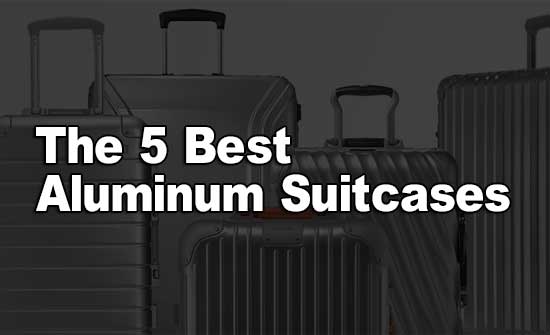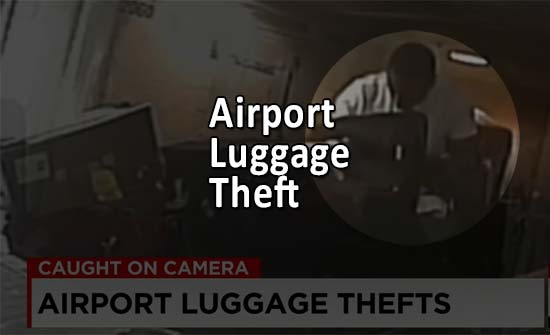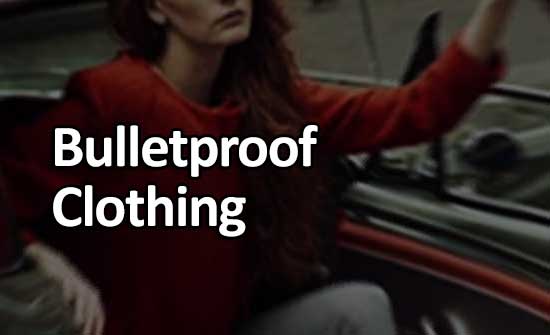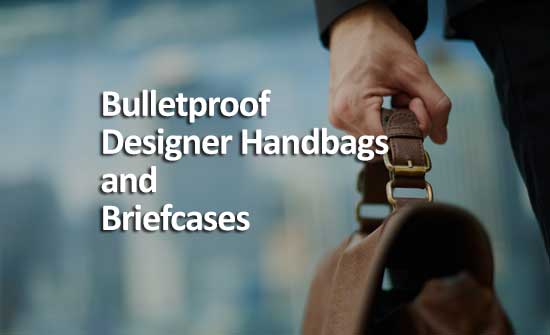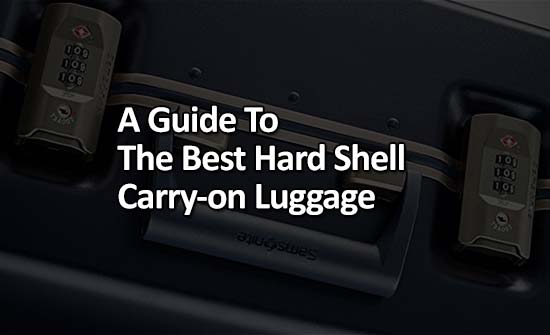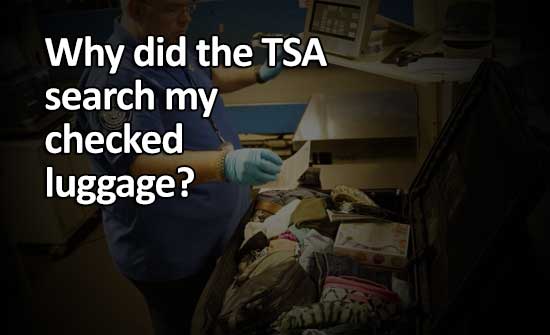
Why Did the TSA Search My Checked Luggage?

Do you ever wonder what would trigger a TSA inspection of your checked luggage? Why did the TSA search my checked luggage?
No matter how often you fly, many people suffer from the paranoid suspicion that they are being targeted by the TSA or other country's screening authorities. Most often this suspicion is rooted in experiences when, on multiple occasions, these folks have received their checked bags and have either found a TSA "Notice Of Baggage Inspection" card has been placed inside of their luggage or their luggage was not properly closed. Some travelers may have also experienced items being broken or missing, adding to the mystery.
This can be annoying, even a little scary to think that some stranger has opened your bag and rifled through your belongings. It's completely understandable. There are a few things that you can do to avoid this and this is why we wrote this page.
When a baggage X-ray detects something in your luggage that may be suspicious and a human cannot determine what it is, your luggage is sent to something called "Secondary Search" where it is opened and searched by hand until the alarm can be resolved. These secondary searches take place in special rooms in the back of the airport and are performed by specially trained TSA Officers. These rooms are under constant closed circuit camera surveillance to minimize theft. Unfortunately, some bad apples find ways around the cameras and steal valuables from checked bags.
Did you know that you can control whether or not your luggage gets sent to secondary search and opened? It is true! On this page, we will list the top seven reasons why your bag is being sent to secondary search and opened.
What's on This Page:
1) The anatomy of a screening system
2) Organic alarms will trigger an alarm
3) Shield alarms will trigger an alarm
4) Undeclared firearms
5) Prohibited items
6) Things that look like prohibited items
7) Old barcode stickers
8) Could your luggage be triggering an alarm?
9) Conclusion
10) Frequently asked questions
11) Sources
The top seven reasons why TSA opened your luggage...
The Anatomy of a screening system
We will keep this very high level but to really understand what goes on with your luggage, you will need to understand a few key elements of the security screening process. I am not giving away any secrets here. All of this information is available on the TSA website.
Almost everyone knows that since 911, every piece of luggage that is loaded onto a commercial airplane is security screened in some way. This is the same all over the world. In almost all cases, this screening is performed by an X-ray machine.
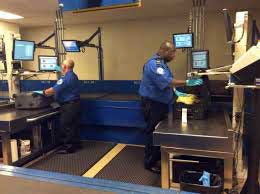 These X-ray scanners are smart and are designed to detect primarily explosives (they do detect other things too). If the luggage that has just been scanned has no threats, it is cleared and sent to be put into a tub cart and loaded onto your airplane.
These X-ray scanners are smart and are designed to detect primarily explosives (they do detect other things too). If the luggage that has just been scanned has no threats, it is cleared and sent to be put into a tub cart and loaded onto your airplane.
Why did the TSA open your checked luggage? If the X-ray suspects that there is something suspicious in the bag, it is rejected and the X-ray image is sent to a human screener. If this screener is unable to clear the bag, it is sent to secondary search where it is opened and inspected by a human (TSA Officer or other screening authority).
It's that simple. No games, no tricks, no deep state tracking you - it's just a machine and a human got suspicious and followed standard operating procedures. It happens thousands of times a day all over the country.
The majority of bags are simple and easy to clear at either the X-ray or the first human but a few need to be opened and human intervention. What we want to do is make sure that your bag is not one of these rejected bags.
This video from the TSA explains the process. It is from 2009 but still valid today:
Here are some things that could get your luggage flagged to be opened and searched:
1) Organic alarms will be flagged by an X-ray
This is probably the most common reason why people's luggage end up getting opened and searched. The X-ray scanners are smart but only so smart. They use X-ray data to compare the information about the contents of your bag with a look-up table of known dangerous substances - mostly explosives.
Unfortunately, many things also have "fingerprints" that make them look a lot like explosives. Most of these things are organic materials.
Funnily, the corners of those big Pelican Progear plastic cases often appear as an organic alarm. They show up all the time in secondary search.
The list is long and this may not be a comprehensive list but it covers that main culprits:
- Peanut butter (number one for a reason)
- Maple Syrup
- Marzipan
- Modelling clay
- Sriracha sauce
- Large bags of sugar/salt/pepper/seasonings
- Large bags of powders
- Large or many tubes of toothpaste
- Large chocolate bars
- Large quantities of various liquids (shampoo, dish soap & more)
- Large number of books
- Large number of magazines with shiny pages (rotogravure paper)
- Tortilla chips
- Large tubs of skin cream
2) Shield alarms will be flagged by an X-ray
A shield alarm is triggered when the X-ray scanner cannot "see through" an object in your luggage. If you cannot see through an item, then you could hide something inside of it. As a result, there is an international understanding that all shield alarms must be sent for manual search.
What to pack or not to pack in order to avoid triggering a shield alarm and having your luggage opened by TSA screening officers is a case of common sense. As a general rule, if it is heavy and made of metal, it at risk of triggering a shield alarm.
Most shield alarms are caused by dense and/or thick metals. Surprisingly, one exception is leaded crystal glass. The lead inside the material can make that beautiful clear glass vase totally opaque to an X-ray. This will get your bag opened for sure.
There have been reports that some materials that in small quantities are fine, trigger shield alarms in larger quantities (for example: some books).
Fun fact: Tinfoil (even a roll of tinfoil) will not trigger a shield alarm!
Some things that trigger shield alarms:- Tools
- Leaded crystal glass
- Golf clubs
- Socket sets
- Most large pieces of metal
- Metal sculptures
- Metal camera tripods
- Hiking or tent poles
- Batteries
- Cymbals
3) Undeclared firearms
Although firearms come under the prohibited item category, we have decided to discuss it separately here. In 2018, the TSA discovered 4,239 guns in carry-on bags. There are no statistics for checked baggage but I know first hand that it happens quite often.
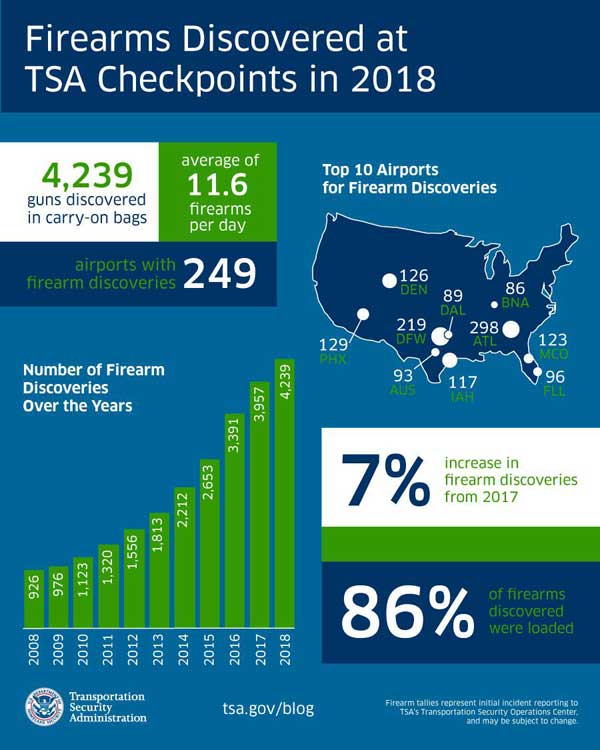
Firearms and ammunition are very easy to pick out of an X-ray image. Screeners are even trained to identify disassembled guns so don't think that you can outsmart them. All you are going to do is get caught. Penalties can range by airport but in the USA you will probably lose your firearm and get a fine. In another country it could be far worse.
There are proper and legal ways to ship your firearms and ammunition by air. Yes, there is paperwork to file but this will ensure that if your bag shows up on the screen of a X-ray screener, if you have the paperwork filed, it will not need to be opened and searched (or confiscated). You can find out everything you need to ship your firearms at the TSA website link: TSA.gov - Transporting firearms and ammunition
From the TSA website: You may transport unloaded firearms in a locked hard-sided container as checked baggage only. Declare the firearm and/or ammunition to the airline when checking your bag at the ticket counter. The container must completely secure the firearm from being accessed. Locked cases that can be easily opened are not permitted.
Here is a list of just some of the items that should be declared to the airline at check-in to avoid having your checked luggage opened.
- Vintage guns (whether they are operational or not)
- Replica firearms (whether they are operational or not)
- Deactivated/inert firearms
- Realistic toy guns
- Paintball guns
- Metal cap guns
- Air gun/rifles
- Homemade firearms
- Flare guns
- All forms of ammunition
- Anything that would appear to be a firearm to an X-ray
4) Prohibited items or dangerous goods
Prohibited items or dangerous goods are any materials that could pose a threat to civil aviation. This refers to things that can start a fire or explode on board an airplane. Most of the list below may seem like common sense but you would be surprised how many travelers think that the rules do not apply to them.
Once again, the TSA security screeners are specially trained to intercept prohibited items in checked bags so please just them at home.
This is another category of items that often confuses travelers. Again you can use common sense to avoid this one too. We have created this list based on the TSA and Transport Canada prohibited items list. You can see more on their websites - links in at bottom of the page.
Some of these items may look ridiculously obvious to you but you know that if it is on the list, at least one person has attempted to check one of these things.
Some prohibited items you should not pack in your checked luggage:- Alcohol over 140 proof
- Ammunition, propellant powder, gunpowder
- Arc Lighters, Plasma Lighters, Electronic Lighters, E-Lighters
- Bear bangers, Bear spray
- Blasting caps
- Butane Curling Irons (cordless)
- Butane refill cans
- Canisters or cartridges that create smoke
- Caustic materials (including acids)
- Carbon dioxide cartridges and other compressed gases
- Cooking spray
- Detonators and fuses
- Electronic Cigarettes and Vaping Devices
- Engine-powered Equipment with Residual Fuel
- English Christmas Crackers
- Fertilizer
- Firecrackers/fireworks
- Flammable paint
- Flares/flare gun
- Gasoline/Propane/Diesel
- Lighter fluid
- Liquid bleach
- Lithium batteries with more than 100 watt hours
- Mines, grenades and other military supplies
- Power Banks/power chargers
- Recreational Oxygen (non-medical)
- Rocket launcher
- Samsung Galaxy Note 7
- Sparklers
- Spillable batteries
- Spray paint/starch
- Strike anywhere matches
- Vehicle Airbags
- Devices designed to stun or immobilize (Tasers, stun batons or animal stunners)
- Chemicals, gases and sprays such as mace, pepper spray or capsicum spray, tear gas, acid sprays and animal repellent sprays
- Brass knuckles
- Switch blade knives
- Concealed knives
- Throwing stars
- Firearms with short barrels
5) Things that look like prohibited items
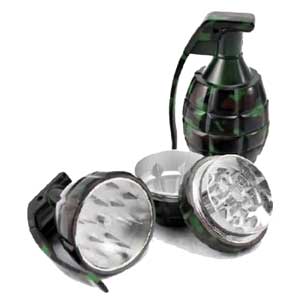 This is another obvious category. Yet, some people think that since an object is a replica, copy or inert, that it is okay to fly with. The problem is when it goes through an X-ray and causes major delays when it triggers the final step in the screening chain - emergency procedures. This usually involves some sort of police involvement and a temporary shut down of parts of the airport. You do not want to be responsible for activating emergency procedures...
This is another obvious category. Yet, some people think that since an object is a replica, copy or inert, that it is okay to fly with. The problem is when it goes through an X-ray and causes major delays when it triggers the final step in the screening chain - emergency procedures. This usually involves some sort of police involvement and a temporary shut down of parts of the airport. You do not want to be responsible for activating emergency procedures...
Remember, you are the only person who knows that your look-a-like hand grenade or mortar shell is not real - so tell someone before they find it. In some cases, these items would be okay if you inform the airline at check-in.
Here is a very short list of things that look like prohibited items:- Replica weapons
- Inert/deactivated weapons (deactivated hand grenades)
- Things that look like weapons (Hand grenade shaped marijuana grinder)
- Inert ammunition (bullet necklace)
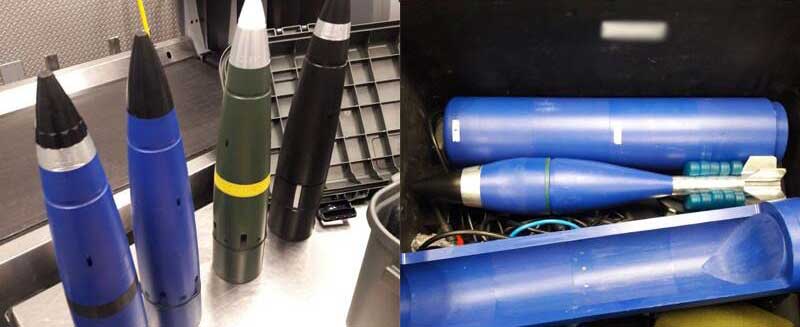
6) Old barcode stickers may cause your bag to be misdirected
Okay, this one is only a remote possibility but it is a good practice to follow. The airport baggage handling system (BHS) uses barcodes stickers on your luggage to track its movement through the security screening system. This is usually done using the barcode on your bag tag that you loop through the handle at check-in.
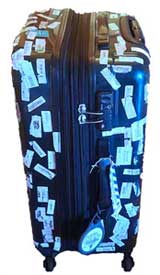 Some airports use a smaller sticker to make sure that it can be read by the barcode readers. Most BHS systems are smart enough know which tag to use if there are more than one barcode on the bag. Unfortunately, there are sometimes mix-ups or in some airports, poorly programmed PLC's (program logic control) and the multiple barcode stickers confuse the baggage handling system.
Some airports use a smaller sticker to make sure that it can be read by the barcode readers. Most BHS systems are smart enough know which tag to use if there are more than one barcode on the bag. Unfortunately, there are sometimes mix-ups or in some airports, poorly programmed PLC's (program logic control) and the multiple barcode stickers confuse the baggage handling system.
What happens if there is a problem? That's easy, your bag, by default is sent to secondary search so a human can figure out what went wrong. And maybe open your bag and search it.
We highly recommend that you remove or cover any old barcode stickers to make absolutely sure that your luggage does not confuse the baggage handling system and get sent to secondary search.
7) Could your luggage be triggering the alarm?
This one may surprise you. The way in which your luggage is built or the materials that it is made with may trigger an alarm and get your suitcase sent to secondary screening and opened by TSA.
As far as I know, there are no commercially made suitcases that will cause an X-ray alarm of any of kinds previously described. This happens more when travelers improvise or repurpose containers as luggage.
There is one brand of luggage made by Pelican Case that I have seen with my own eyes tripper organic alarms. How can this be, when it is made from plastic? Remember when I told you that baggage X-rays are smart in some ways but not so smart in others?
Well the Pelican Case Progear Elite luggage is actually a product that they have been selling for years but it has been prettied-up with interior features to make it into luggage. It is still the old Pelican case. From my observations, the curved corners and edges of the case provide just the right signature to the X-ray to look like an alarm.
Rest assured that normal hard side luggage does not trigger organic alarms. I have X-rayed all of my luggage and none of it came close to triggering an alarm.
Another issue I have observed is when handles that the baggage tag has been affixed to are ripped off in the baggage system. This happens far more often than you may think. And remember where a bag without a baggage tag ends up - secondary search, Just where you are trying to avoid. Keeping your luggage - especially the handles in good condition is a very good idea.
Conclusion
TSA and other screening authorities around the world screen our luggage to make flying safer.
No, it is not enjoyable opening your luggage upon arrival at your destination to find that TSA card informing your that some faceless stranger has searched your suitcase. Remember, this was done "for-cause". They are not picking on you or targeting you in any way. Something that you packed triggered an alarm.
If you avoid packing items that will trigger these false alarms, you will never have your luggage searched again.
Frequently Asked Questions
Should I lock my luggage when flying to Europe?
Yes. You should always lock your luggage. This applies no matter if you are flying on a domestic flight within the United States or anywhere else in the world. Theft and smuggling are rampant in most airports around the world and locking your suitcase will make it a little bit harder to get into. Hopefully, this will encourage any bad guys to move onto the next piece of luggage.
Does the airport scan checked luggage?
Yes, all commercial airports in the world are required by their regulators (TSA, Transport Canada, ECAC) to screen 100% of all luggage being loaded on to commercial aircraft. The only airports that are not required to scan luggage are FBO's or Fixed based operations airports. These are the airports that private aircraft fly in and out of.
What do airport bag scanners see?
Airport X-ray scanners see a wide range of materials. These are generally divided into organic, inorganic and mixed materials. So X-rays scanners can see everything in your bag. If the scanner cannot penetrate something in your luggage because it is too dense, your luggage will be opened and search by hand.
How to hide things from airport scanners?
Don't put it through an airport scanner. :) Sorry but there is no way to hide things from a scanner. If you place something in or behind something that blocks the X-ray beam, your luggage will be opened and searched by hand. So you are beaten either way.
TSA red flags
This is more of an X-ray red flag answer. X-ray scanners are looking for things that look like explosives. Anything that you pack in your luggage that looks close to being an explosive will be a red flag for the X-ray. There are many common items that appear similar to explosive for an X-ray scanner. Things like peanut butter, maple syrup and large bags of powders.
Is tinfoil X-ray proof?
Not even close! The energy from a typical baggage X-ray will easily blast through tinfoil like it is not even there. At best, it may leave a faint shadow (on the X-ray image) over whatever it is wrapped around.
How do I prevent my valuables from being stolen by TSA airport security screeners?
Try to keep your luggage and its contents from triggering organic or shield alarms that will require the bag to be opened to resolve the alarm. To be absolutely sure that they are safe, only pack your valuables in your carry-on bag.
Sources:
As an Amazon Associate I earn from qualifying purchases.
Copyright © 2014 - 2024 SafeSuitcases.com - All rights reserved



























